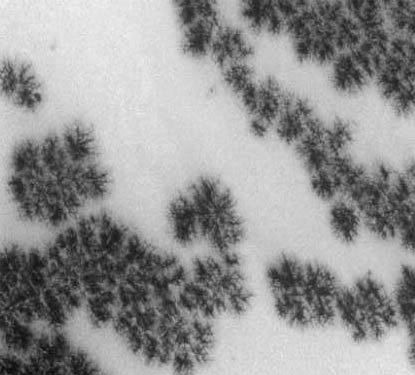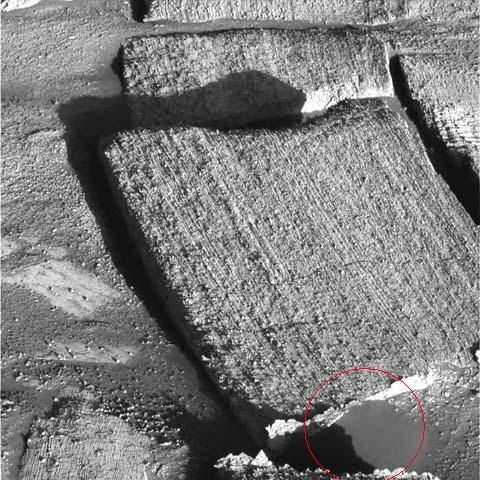"A Cold, Dry, Dead Planet"
Renewed Hope for Life on the Red Planet
"For those seeking life on Mars, it is the best of times and the worst of times. Nearly 35 years after NASA’s twin Viking robots eased down onto its ruddy surface, there is still no incontrovertible evidence that living organisms ever existed on the fourth planet from the sun. Few researchers accept one scientist’s claims that the 1976 Viking experiment detected life. The brief frenzy over possible fossils in a Mars meteorite has fizzled. And even after billions of dollars’ worth of adorable rovers and eagle-eyed orbiters have prodded and probed the planet, the results have been at best ambiguous and at times downright confusing.
Yet a growing number of space scientists are upbeat, even buoyant, about the likelihood that Mars is a living world. “A variety of discoveries are creating a kind of buzz,” says Chris McKay, an astrogeophysicist at NASA Ames Research Center in Mountain View, California. “And people seem more enthusiastic. It’s group psychology.” There has been no single major breakthrough in the search, but a subtle change is taking place within the clubby community dedicated to finding and bringing back organisms—dead or alive—from the Red Planet.
“It is not now considered a stupid idea to look for life on Mars,” says Bruce Jakosky, a planetary geologist at the University of Colorado at Boulder."
Jeez, you think?



To me these show vegetation growing exactly like vegetation on earth, in various stages of life cycles, more abundant in places that accumulate moisture. My speculation is that it would be succulent in nature, very slow growing and quite huge to increase the interior storage capacity relative to exposed surface. The first picture probably shows the dominant growth patterns, radiating outward in spurts from an established central mass, but there are things that look for all the world like conifer trees.
Now if only there was standing water...



This last picture was taken by one of the Mars rovers looking back and down at the tracks it just made through mud. Look at the lower right, see a puddle?
Mars Rover Gets Miraculous Cleaning
"The rovers Spirit and Opportunity landed on Mars in January 2004. When their missions began, their solar cells were providing 900 watt-hours of electricity per day. But over the months that followed Spirit’s output dropped to 400 watt-hours daily, while Opportunity dropped to about 500 watt-hours. One reason for the drop was the accumulation of dust on the panels.
But then, in one of the great surprises of the rover missions, Opportunity’s power began to increase, and kept on increasing until the power peaked at just over 900 watt-hours.
As reported by Newscientist.com, the Mars rover Opportunity “stumbled into something akin to a carwash,” which somehow “cleaned” its solar panels."
"For those seeking life on Mars, it is the best of times and the worst of times. Nearly 35 years after NASA’s twin Viking robots eased down onto its ruddy surface, there is still no incontrovertible evidence that living organisms ever existed on the fourth planet from the sun. Few researchers accept one scientist’s claims that the 1976 Viking experiment detected life. The brief frenzy over possible fossils in a Mars meteorite has fizzled. And even after billions of dollars’ worth of adorable rovers and eagle-eyed orbiters have prodded and probed the planet, the results have been at best ambiguous and at times downright confusing.
Yet a growing number of space scientists are upbeat, even buoyant, about the likelihood that Mars is a living world. “A variety of discoveries are creating a kind of buzz,” says Chris McKay, an astrogeophysicist at NASA Ames Research Center in Mountain View, California. “And people seem more enthusiastic. It’s group psychology.” There has been no single major breakthrough in the search, but a subtle change is taking place within the clubby community dedicated to finding and bringing back organisms—dead or alive—from the Red Planet.
“It is not now considered a stupid idea to look for life on Mars,” says Bruce Jakosky, a planetary geologist at the University of Colorado at Boulder."
Jeez, you think?



To me these show vegetation growing exactly like vegetation on earth, in various stages of life cycles, more abundant in places that accumulate moisture. My speculation is that it would be succulent in nature, very slow growing and quite huge to increase the interior storage capacity relative to exposed surface. The first picture probably shows the dominant growth patterns, radiating outward in spurts from an established central mass, but there are things that look for all the world like conifer trees.
Now if only there was standing water...



This last picture was taken by one of the Mars rovers looking back and down at the tracks it just made through mud. Look at the lower right, see a puddle?
Mars Rover Gets Miraculous Cleaning
"The rovers Spirit and Opportunity landed on Mars in January 2004. When their missions began, their solar cells were providing 900 watt-hours of electricity per day. But over the months that followed Spirit’s output dropped to 400 watt-hours daily, while Opportunity dropped to about 500 watt-hours. One reason for the drop was the accumulation of dust on the panels.
But then, in one of the great surprises of the rover missions, Opportunity’s power began to increase, and kept on increasing until the power peaked at just over 900 watt-hours.
As reported by Newscientist.com, the Mars rover Opportunity “stumbled into something akin to a carwash,” which somehow “cleaned” its solar panels."





0 Comments:
Post a Comment
<< Home